15.04.24: Faith Ringgold has died at the age of 93. The artist who trained as a painter and sculptor before teaching in the New York public school system for several years, turned to more political paintings in the 1960s and began making her famous ‘story quilts’, which also incorporated her writing, in the 1980s. Ringgold was the subject of retrospectives at the the Studio Museum in Harlem and the National Museum of Women in the Arts and widely recognised as a modernist who placed Black figures and particularly Black women at the centre of modern art. Nicole Rudick reviewed her retrospective at the New Museum in 2022, the same year Ringgold was Apollo’s artist of the year.
From the April 2022 issue of Apollo. Preview and subscribe here.
In November 1970, Faith Ringgold co-organised ‘The People’s Flag Show’ at the Judson Memorial Church in New York, a group exhibition that protested the Vietnam War and insisted on artists’ First Amendment right to use the American flag as material. She and her fellow organisers were arrested and charged with desecration of the flag, but the next month, she delivered a speech at Judson and began by reiterating the community’s ‘commitment to raise the experience of human existence from a mere mechanical exchange of art and money to a cultural revolution for people through art’. This declaration – that art is for all people, as makers, subjects and viewers – finds continuous expression in Ringgold’s work. For 60 years, she has made art about her own experiences and those of women, children, immigrants and the Black community – in other words, the American experience. Ringgold also understood that the road to achieving her aims was steeper for her than for others, but she was undaunted: ‘If I believed in a revolutionary black art form to reflect the black society, I was going to have to be a woman, be a black woman and do it.’
Ringgold’s work is as relevant and committed today as it was when when she conceived it. Now 91 and still making art, she is the subject of a full retrospective at the New Museum. The institutions’s upper galleries are devoted to some 175 works – posters, paintings, masks, soft sculptures, painted fabric pieces, books, story-quilts and ephemera – made between 1962 and 2010 that allow viewers to reckon with Ringgold’s career, influence and legacy.
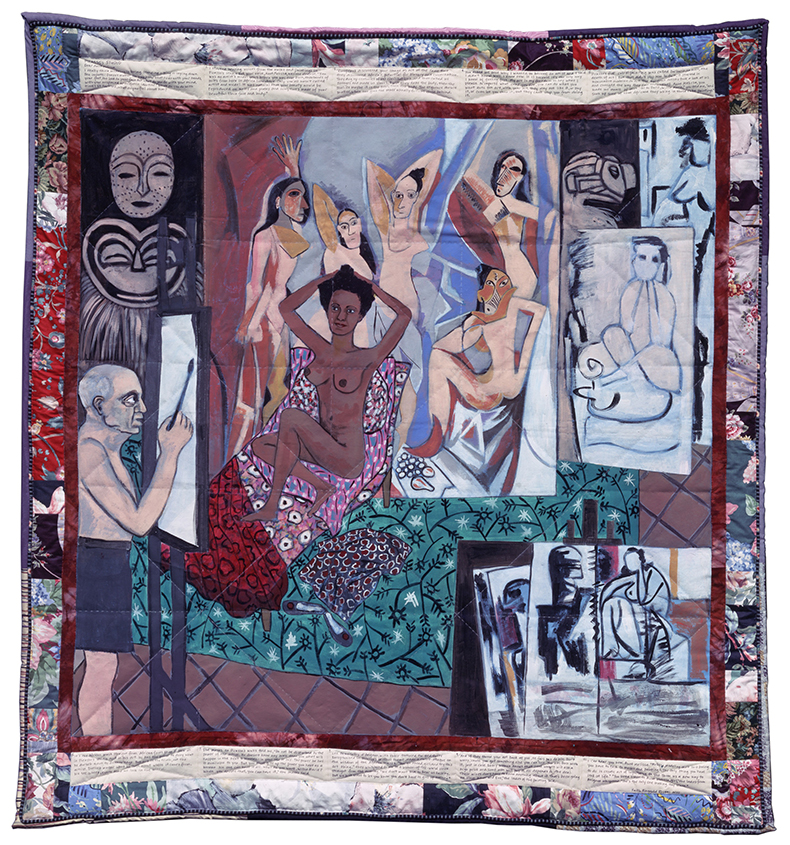
Picasso’s Studio: The French Collection Part I, #7 (1991), Faith Ringgold. Worcester Art Museum. Courtesy ACA Galleries, New York 2022; © Faith Ringgold/ARS, NY and DACS, London
Born in Harlem in 1930, Ringgold was married, divorced and a mother of two by the age of 24. Once on her own, she earned degrees in fine art from City College and began an 18-year career teaching art in New York City public schools. In 1964, she was spurned by Romare Bearden when she sought an invitation to join Spiral, a newly formed, influential collective of Black artists (Emma Amos was the only woman of the group). Instead, Ringgold joined Spectrum Gallery, on 57th Street, four blocks north of the Museum of Modern Art, in what was then the heart of the New York City art world. She was the only Black member of the cooperative gallery, and in her first solo show there, in 1967, she exhibited paintings from her American People series, which addressed the failings of American society. The Civil Rights Triangle (1963), for instance, depicts five figures, all men: at the apex stands a white man, flanked by three well-dressed Black men; at the triangle’s lowest point is a working-class Black man, partly obscured by the higher-ups. In one of her most famous paintings from this series, The Flag Is Bleeding (1967), a white woman links arms with a Black man and a white man. They are imprisoned behind the American flag, its red stripes bleeding down the canvas, no longer a symbol of freedom but of constraint. There is no Black woman in the painting. ‘Black women were literally out of the picture,’ Ringgold said in a recent interview. ‘Period.’
She was determined to work within the same institutions she sought to redefine. Beginning in the late 1960s, she agitated against sexism and racism in the art world, criticising MoMA and the Whitney Museum of American Art, for instance, for their unerring support of ‘superstar white male artists’, as Ringgold puts it in her excellent memoir. In 1971, she and her daughter Michele Wallace founded Women Students and Artists for Black Art Liberation to address racism within the women’s movement. That same year, Ringgold helped found Where We At, a collective of Black women artists, and the group presented the Brooklyn Museum of Art with a list of demands, including that it ‘provide day-care centers or children’s workshops so that mothers can attend classes’.
The same was true of her relationship to the ‘superstars’ who prospered in these settings. Jasper Johns’s flag paintings inspired The Flag Is Bleeding and Ringgold’s other flag-based paintings from the series, but she felt that his flags offered ‘a beautiful, but incomplete, idea’ and she wanted to introduce ‘some of the hell that had broken out in the States’. In Black Light Series (1967–68), Ringgold disrupted the nonobjective, contemplative ‘black paintings’ of Ad Reinhardt and Josef Albers by inserting mask-like faces that peer out from geometric blocks of black pigments. The dark colours stand in for white as a source of light, eliciting both the ‘Black Is Beautiful’ movement and the notion of invisibility in Ralph Ellison’s novel Invisible Man.
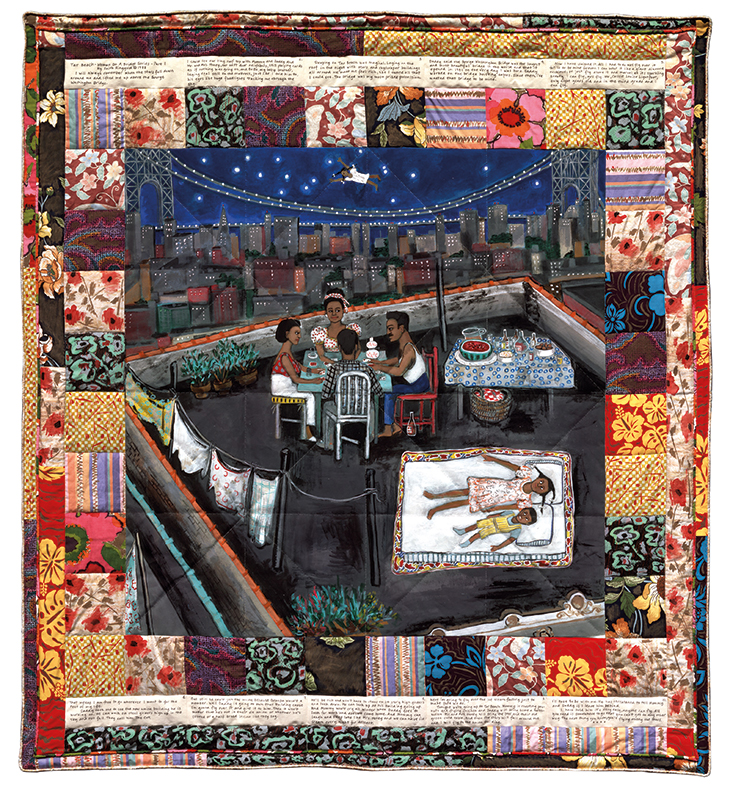
Woman on a Bridge #1 of 5: Tar Beach (1988), Faith Ringgold. Solomon R. Guggenheim Museum, New York. Courtesy ACA Galleries, New York 2022; © Faith Ringgold/ARS, NY and DACS, London
She also disrupted the strict formal grids of minimalist compositions with works such as For the Women’s House (1971), commissioned as a mural for the Women’s House of Detention at Rikers Island. She based the structure of the painting on the geometric designs of Kuba textiles, from what is now the Democratic Republic of the Congo. A large rectangle divided into a starburst of eight triangles depicts Black and white women in various roles: basketball player, police officer, doctor, bus driver and president of the United States. At the unveiling, she said, ‘Here we do not impress each other with our money, our status, or our clothes. Here we impress each other with each other.’
In 1980, Ringgold completed a memoir but couldn’t find a publisher. Instead, she put the writing into her art, stitching lines of prose into story-quilts, which she began that same year. She also ‘self-published’ the memoir, she has said, through performance pieces and public readings of the story-quilts. Although her performance work isn’t explored in the exhibition, the curators have gathered 37 story-quits, including the dozen that make up The French Collection (1991–97), in the series’ first complete presentation in nearly 25 years, and Echoes of Harlem, Ringgold’s first story-quilt, which she made with her mother, Willi Posey. Posey was a dressmaker and clothing designer and had already collaborated with Ringgold on her soft sculptures, masks, and tankas, fabric-based works inspired by sacred Tibetan paintings. Like this earlier work, the quilts incorporate elements of painting and textiles and depict an intimate narrative history of Black people in America and Europe. They occupied Ringgold for some two decades and are perhaps her best-known works.
When her memoir finally appeared from Bulfinch Press in 1995, its title, We Flew Over the Bridge, referred to the lore that some enslaved people flew to freedom. That notion reappears in the first of her Woman on a Bridge story-quilt series, Tar Beach (1988), which became the basis for her award-winning children’s book of the same name, published in 1991. ‘Anyone can fly,’ says the book’s young heroine. ‘All you need is somewhere to go that you can’t get to any other way.’

American People Series #18; The Flag is Bleeding (1967), Faith Ringgold. National Gallery of Art, Washington, D.C. Courtesy ACA Galleries, New York 2022; © Faith Ringgold/ARS, NY and DACS, London
‘Faith Ringgold: American People’ is at the New Museum, New York, until 5 June.
From the April 2022 issue of Apollo. Preview and subscribe here.
Unlimited access from just $16 every 3 months
Subscribe to get unlimited and exclusive access to the top art stories, interviews and exhibition reviews.

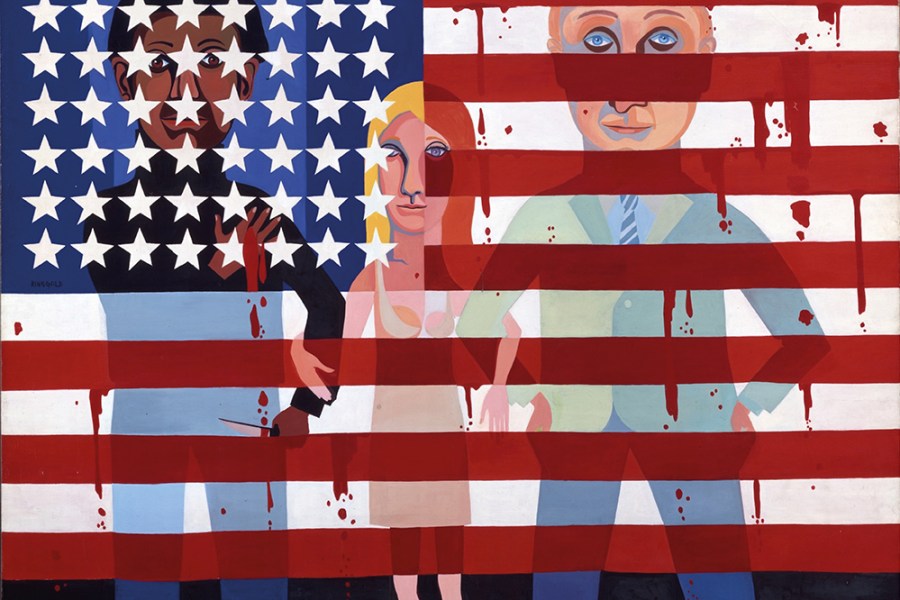
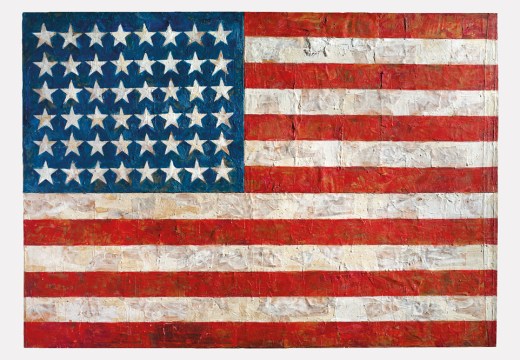
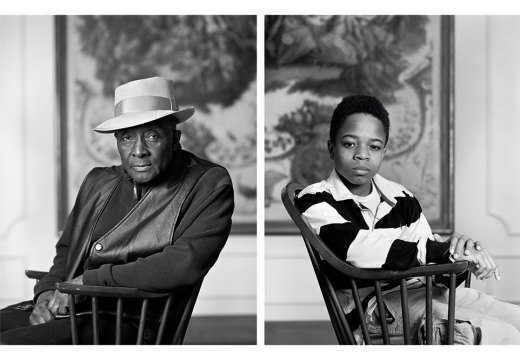
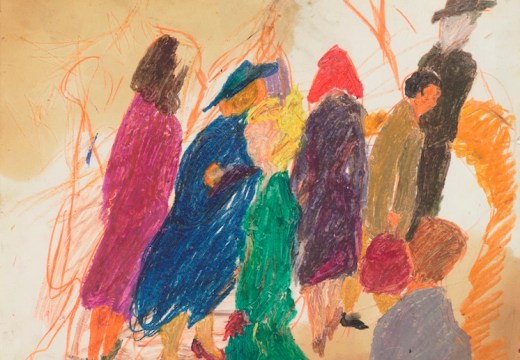









![Masterpiece [Re]discovery 2022. Photo: Ben Fisher Photography, courtesy of Masterpiece London](http://www.apollo-magazine.com/wp-content/uploads/2022/07/MPL2022_4263.jpg)
It’s time for the government of London to return to its rightful home